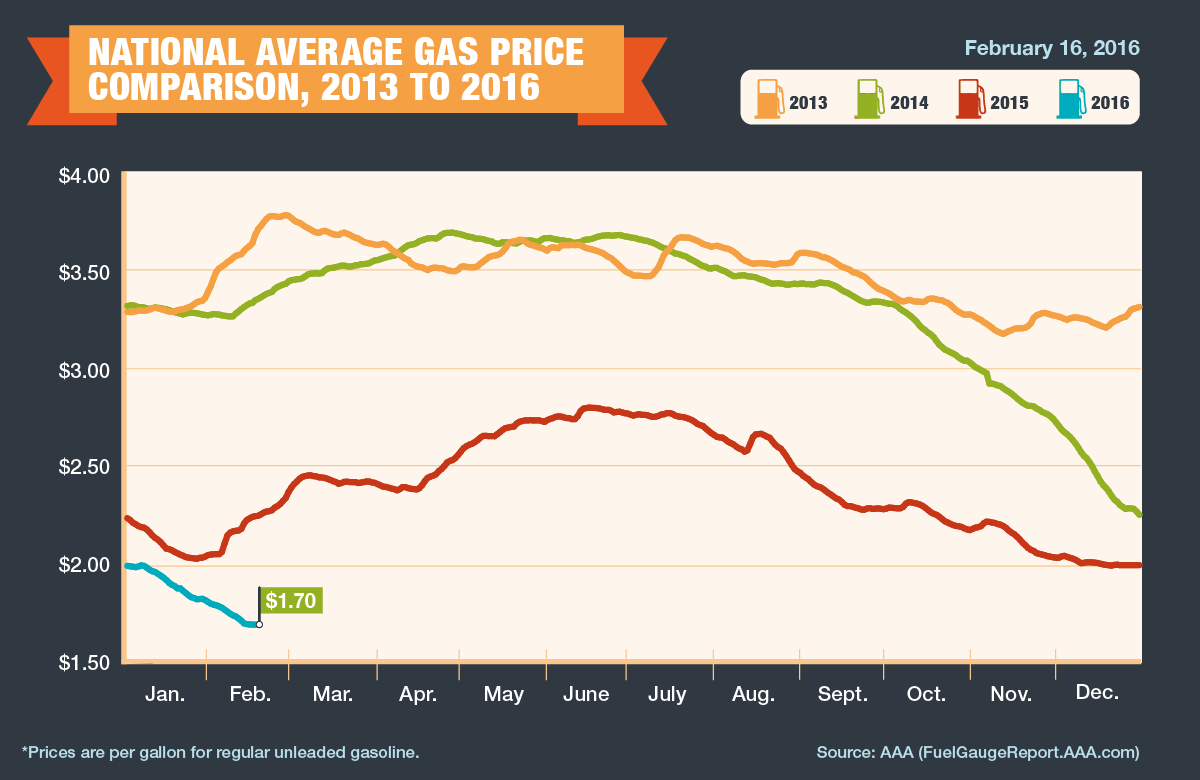(WASHINGTON, February 16, 2016) The national average price of gas increased today for the first time in 20 days, but average prices are still at levels not seen since January 2009. The national average has fallen for 42 out of 47 days this year for a total savings of 30 cents per gallon. Today’s average price of $1.70 represents a savings of three cents per gallon on the week, 20 cents per gallon on the month and 55 cents per gallon compared to this same date last year.
Typical for this time of year, refinery production is beginning to drop as many refineries prepare for seasonal maintenance in advance of the summer driving season. In addition, some refineries reportedly have cut production because of abundant supplies and low prices. This decline in production has led to higher prices throughout the Midwest and slowed recent declines in the national average price of gas. Industry analysts expect this year’s spring maintenance season to peak in April, and pump prices are likely to rise in the coming months due to fluctuations in supply and demand associated with this process. However, unlike previous years, gasoline inventories are reportedly at higher-than-normal levels and the price of crude oil remains low. The combination of these two factors should help keep gas prices relatively low compared to recent years, though prices are likely to be a good deal higher by Memorial Day than they are today.
Hawaii ($2.61) is the nation’s most expensive market for retail gasoline and averages in the state are 21 cents per gallon higher than second-place California ($2.40). Alaska ($2.26), Nevada ($2.07) and Washington ($2.04) round out the top five most expensive markets and are the only states where drivers are paying average prices above the $2 per gallon threshold. The nation’s least expensive markets for gas are Oklahoma ($1.41), Missouri ($1.41) and Kansas ($1.44), and motorists in a total of 34 states are paying averages at or below $1.75 per gallon.
Gas prices in the majority of states (43) are down on the week. The largest weekly savings are in states west of the Rockies, including Nevada (-12 cents), California (-10 cents) and Arizona (-10 cents). Consumers in 11 states are benefitting from savings of a nickel or more per gallon over this same period. On the other end of the spectrum, prices are higher week-over-week in seven states with the biggest jumps in the Midwestern states of Indiana (+7 cents), Ohio (+7 cents) and Michigan (+6 cents). Several refineries in this region have reduced production due to lower prices and abundant supplies, and pump prices could continue to rise throughout the region as a result.
Monthly savings persist in every state and Washington, D.C., and with the exception of Hawaii (-3 cents) retail averages are down by double digits over this same period. Averages are lower in nine states by a quarter or more per gallon with the largest drops in California (-38 cents), Nevada (-36 cents) and Washington (-30 cents). This time last month the West Coast was dealing with lingering refinery challenges, which caused prices to move noticeably higher in the region. These refinery issues appear to be largely resolved and supply in the region has reportedly recovered, helping to push prices lower month-over-month.
The magnitude of yearly savings is beginning to widen again and retail averages are down in every state and Washington, D.C. year-over-year. Pump prices in the vast majority of states (47) are down by a quarter or more per gallon compared to a year ago, and motorists in 28 states are paying averages that are 50 cents or more per gallon less than this same date last year. The largest savings in price are in the Midwestern states of Illinois (-81 cents), Indiana (-76 cents), Michigan (-73 cents) and Ohio (-73 cents).
Speculation about future supply and demand is contributing to swings in the global price of crude oil. Market fundamentals continue to point to oversupply, though prices may continue to fluctuate in the near-term as rumors of production cuts and possible deals between OPEC and non-OPEC member countries influence the market.
Despite the lower price environment, there has not yet been a major reduction in U.S. oil production. WTI fell to its lowest point in nearly 13 years last week, largely due to an abundance of domestic oil supplies. The latest data from the EIA indicated a drop in crude oil stocks for the first time this year, though inventories remain elevated and are likely to increase in the coming weeks.
WTI rallied to end the week, and at the close of Friday’s formal trading session on the NYMEX, was up $3.23 to settle at $29.44 per barrel. The NYMEX was closed yesterday in observance of the President’s Day holiday.
Motorists can find current gas prices along their route with the free AAA Mobile app for iPhone, iPad and Android. The app can also be used to map a route, find discounts, book a hotel and access AAA roadside assistance. Learn more at AAA.com/mobile.



